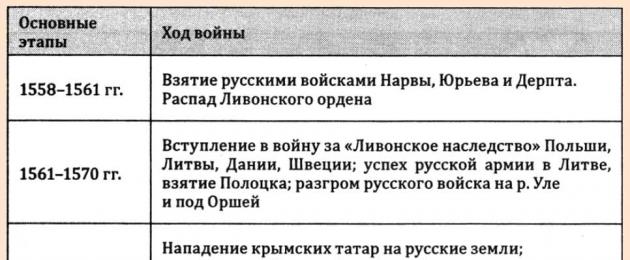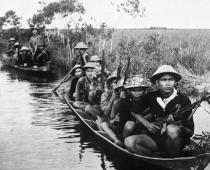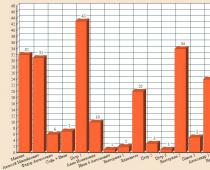The best that history can give us is the enthusiasm it generates.
The Livonian War lasted from 1558 to 1583. During the war, Ivan the Terrible sought to gain access to and seize the port cities of the Baltic Sea, which was to significantly improve the economic situation of Russia by improving trade. In this article, we will talk briefly about the Levonian War, as well as all its aspects.
The beginning of the Livonian War
The sixteenth century was a period of incessant wars. The Russian state sought to protect itself from its neighbors and return the lands that were previously part of Ancient Rus.
The wars were fought along several lines:
- The eastern direction was marked by the conquest of the Kazan and Astrakhan khanates, as well as the beginning of the development of Siberia.
- The southern direction of foreign policy represented the eternal struggle with the Crimean Khanate.
- Western direction - the events of a long, difficult and very bloody Livonian War (1558-1583), which will be discussed.
Livonia is a region in the eastern Baltic. On the territory of modern Estonia and Latvia. In those days, there was a state created as a result of the crusader conquests. As a state entity, it was weak due to national contradictions (the Baltic people were placed in feudal dependence), religious schism (the Reformation penetrated there), and the struggle for power among the elite.
Livonian War Map
Reasons for the start of the Livonian War
Ivan 4 the Terrible started the Livonian War against the backdrop of the success of his foreign policy in other areas. The Russian prince-tsar strove to push the state borders back in order to gain access to the shipping areas and ports of the Baltic Sea. And the Livonian Order gave the Russian Tsar ideal reasons for starting the Livonian War:
- Refusal to pay tribute. In 1503, the Livni Order and Russia signed a document, according to which the first were obliged to pay the city of Yuryev an annual tribute. In 1557, the Order single-handedly removed itself from this obligation.
- Weakening of the external political influence of the Order against the background of national disagreements.
Speaking of the reason, emphasis should be placed on the fact that Livonia separated Russia from the sea, blocked trade. Large merchants and nobles who wanted to appropriate new lands were interested in the capture of Livonia. But the main reason is the ambitions of Ivan IV the Terrible. The victory was supposed to strengthen his influence, so he fought the war, regardless of the circumstances and the meager capabilities of the country for the sake of his own greatness.
The course of the war and the main events
The Livonian War was fought with long intervals and is historically divided into four stages.

The first stage of the war
At the first stage (1558-1561), hostilities were relatively successful for Russia. In the first months, the Russian army captured Dorpat and Narva and was close to capturing Riga and Revel. The Livonian Order was on the verge of death and asked for an armistice. Ivan the Terrible agreed to stop the war for 6 months, but this was a huge mistake. During this time, the Order passed under the protectorate of Lithuania and Poland, as a result of which Russia received not 1 weak, but 2 strong opponents.
The most dangerous adversary for Russia was Lithuania, which at that time could in some aspects surpass the Russian kingdom in its potential. Moreover, the Baltic peasants were unhappy with the newly arrived Russian landowners, the cruelty of the war, extortions and other disasters.
Second stage of the war
The second stage of the war (1562-1570) began when the new masters of the Livonian lands demanded that Ivan the Terrible withdraw his troops and abandon Livonia. In fact, it was proposed that the Livonian War end, and Russia was left with nothing as a result. After the Tsar's refusal to do this, the war for Russia finally turned into an adventure. The war with Lithuania lasted 2 years and was unsuccessful for the Russian Kingdom. The conflict could be continued only under the conditions of the oprichnina, especially since the boyars were against the continuation of hostilities. Earlier, for dissatisfaction with the Livonian War, in 1560 the tsar dispersed the "Chosen Rada".
It was at this stage of the war that Poland and Lithuania united into a single state - the Polish-Lithuanian Commonwealth. It was a strong power that everyone, without exception, had to reckon with.
Third stage of the war
The third stage (1570-1577) is the battles of local importance between Russia and Sweden for the territory of modern Estonia. They ended without any meaningful results for both sides. All battles were of a local nature and had no significant impact on the course of the war.
Fourth stage of the war
At the fourth stage of the Livonian War (1577-1583), Ivan IV again captures the entire Baltic region, but soon the tsar's luck turned away and the Russian troops were defeated. The new king of the united Poland and Lithuania (Rzecz Pospolita) Stefan Batory expelled Ivan the Terrible from the Baltic region, and even managed to capture a number of cities already on the territory of the Russian kingdom (Polotsk, Velikiye Luki, etc.). The hostilities were accompanied by terrible bloodshed. Assistance to the Commonwealth since 1579 was provided by Sweden, which operated very successfully, capturing Ivangorod, Yam, Koporye.
The defense of Pskov saved Russia from complete defeat (from August 1581). During the 5 months of the siege, the garrison and residents of the city repulsed 31 assault attempts, weakening the army of Batory.
The end of the war and its results

The Yam-Zapolsk truce between the Russian kingdom and the Commonwealth of 1582 put an end to a long and unnecessary war. Russia abandoned Livonia. The coast of the Gulf of Finland was lost. It was captured by Sweden, with which the Plus Peace Treaty was signed in 1583.
Thus, the following reasons can be distinguished for the defeat of the Russian state, which is summing up the results of the Liovna war:
- adventurism and ambitions of the tsar - Russia could not wage a war simultaneously with three strong states;
- the pernicious influence of the oprichnina, economic ruin, Tatar attack.
- A deep economic crisis within the country, which broke out at the 3rd and 4th stages of hostilities.
Despite the negative outcome, it was the Livonian War that determined the directions of Russia's foreign policy for many years to come - to gain access to the Baltic Sea.
History of Russia / Ivan IV the Terrible / Livonian War (briefly)
Livonian War (briefly)
Livonian War - a short description
After the conquest of the rebellious Kazan, Russia sent its forces to the capture of Livonia.
Researchers identify two main reasons for the Livonian War: the need for trade of the Russian state in the Baltic, as well as the expansion of possessions. The struggle for dominance over the Baltic waters was between Russia and Denmark, Sweden, as well as Poland and Lithuania.
Reason for the outbreak of hostilities (Livonian War)
The main reason for the outbreak of hostilities was the fact that the Livonian Order did not pay the tribute that it was supposed to pay under the peace treaty of 1954.
The Russian army invaded Livonia in 1558. At first (1558-1561) several castles and cities were taken (Yuriev, Narva, Dorpat).
However, instead of continuing a successful offensive, the Moscow government grants the order a truce, while at the same time equipping a military expedition against Crimea. The Livonian knights, using the support, gathered forces and defeated the Moscow troops a month before the end of the armistice.
Against the Crimea, Russia did not achieve a positive result from the hostilities.
The opportunity was also missed for the victory in Livonia. Master Kettler signed an agreement in 1561, according to which the order passed under the protectorate of Poland and Lithuania.
After the conclusion of peace with the Crimean Khanate, Moscow concentrated its forces on Livonia, but now, instead of a weak order, it had to face several powerful contenders at once. And if at first it was possible to avoid a war with Denmark and Sweden, then a war with the Polish-Lithuanian king was inevitable.
The greatest achievement of the Russian troops in the second stage of the Livonian War was the capture of Polotsk in 1563, after which there were many fruitless negotiations and unsuccessful battles, as a result of which even the Crimean Khan decided to abandon the alliance with the Moscow authorities.
The final stage of the Livonian War
The final stage of the Livonian War (1679-1683)- the military invasion of the Polish king Batory in Russia, which at the same time was at war with Sweden.
In August, Stefan Batory took Polotsk, and a year later Velikie Luki and small towns were taken. On September 9, 1581, Sweden took Narva, Koporye, Yam, Ivangorod, after which the struggle for Livonia ceased to be relevant for Grozny.
Since it was impossible to wage war with two enemies, the king concludes an armistice with Bathory.
The result of this war the conclusion was perfect two agreements that are not beneficial for Russia, as well as the loss of many cities.
Main events and chronology of the Livonian War
Schematic map of the Livonian War
Interesting materials:
The Livonian War in the History of Russia.
The Livonian War is a major armed conflict of the 16th century between the Livonian Confederation, the Russian Kingdom and the Grand Duchy of Lithuania. The kingdoms of Sweden and Denmark were also involved in the conflict.
Military actions, for the most part, were carried out on the territory where the Baltic countries, Belarus, as well as the North-West region of the Russian Federation are currently located.
Causes of the Livonian War.
The Livonian Order owned a huge part of the Baltic lands, but by the 16th century it began to lose power due to internal strife and the Reformation.
Due to its coastal position, the lands of Livonia were considered convenient for trade routes.
Fearing the growth of Rus, Livonia did not allow Moscow to trade there in full force. The result of this policy was the hostility of the Russians towards their neighbors.
In order not to give Livonia into the hands of one of the European powers, which could conquer the lands of the weakening state, Moscow decided to reclaim the territories itself.
Livonian War 1558-1583.
The beginning of the Livonian War.

The hostilities began with the fact of the attack of the Russian kingdom on the territory of Livonia in the winter of 1558.
The war lasted in several stages:
- First stage. Russian troops conquered Narva, Dorpat and other cities.
- The second stage: the liquidation of the Livonian Confederation took place in 1561 (the Vilnius Treaty).
The war took on the character of a confrontation between the Russian kingdom and the Grand Duchy of Lithuania.
- Stage three. In 1563, the Russian army conquered Polotsk, but a year later was defeated at Chashniki.
- Fourth stage. The Grand Duchy of Lithuania in 1569, joining forces with the Kingdom of Poland, turns into the Rzeczpospolita. In 1577 Russian troops siege Revel, lose Polotsk and Narva.
The end of the war.
Livonian war ended in 1583 after the signing of two peace treaties: Yam-Zapolsky (1582) and Plyussky (1583)
Under the treaties, Moscow lost all the conquered lands and border territories with Rech: Koporye, Yam, Ivangorod.
The lands of the Livonian Confederation were divided between the Commonwealth, the Swedish and Danish kingdoms.
Results of the Livonian War.
For a long time, Russian historians have characterized the Livonian War as an attempt by Russia to reach the Baltic Sea. But today the reasons and causes of the war have already been revised. Interesting to track, what were the results of the Livonian war.
The war marked the end of the existence of the Livonian Order.
The military actions of Livonia provoked a change in the internal policy of the countries of Eastern Europe, due to which a new state appeared - the Commonwealth, which for another hundred years kept the whole of Europe in fear on an equal footing in the Roman Empire.
As for the Russian kingdom, the Livonian War became a catalyst for an economic and political crisis in the country and led to the decline of the state.
- In contact with 0
- Google+ 0
- OK 0
- Facebook 0








